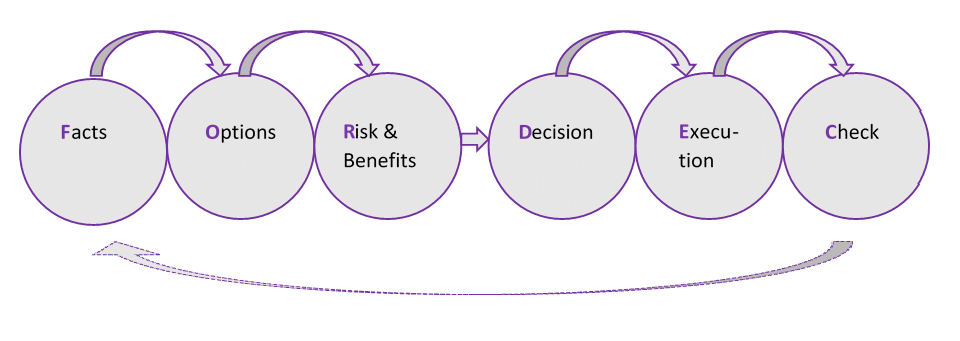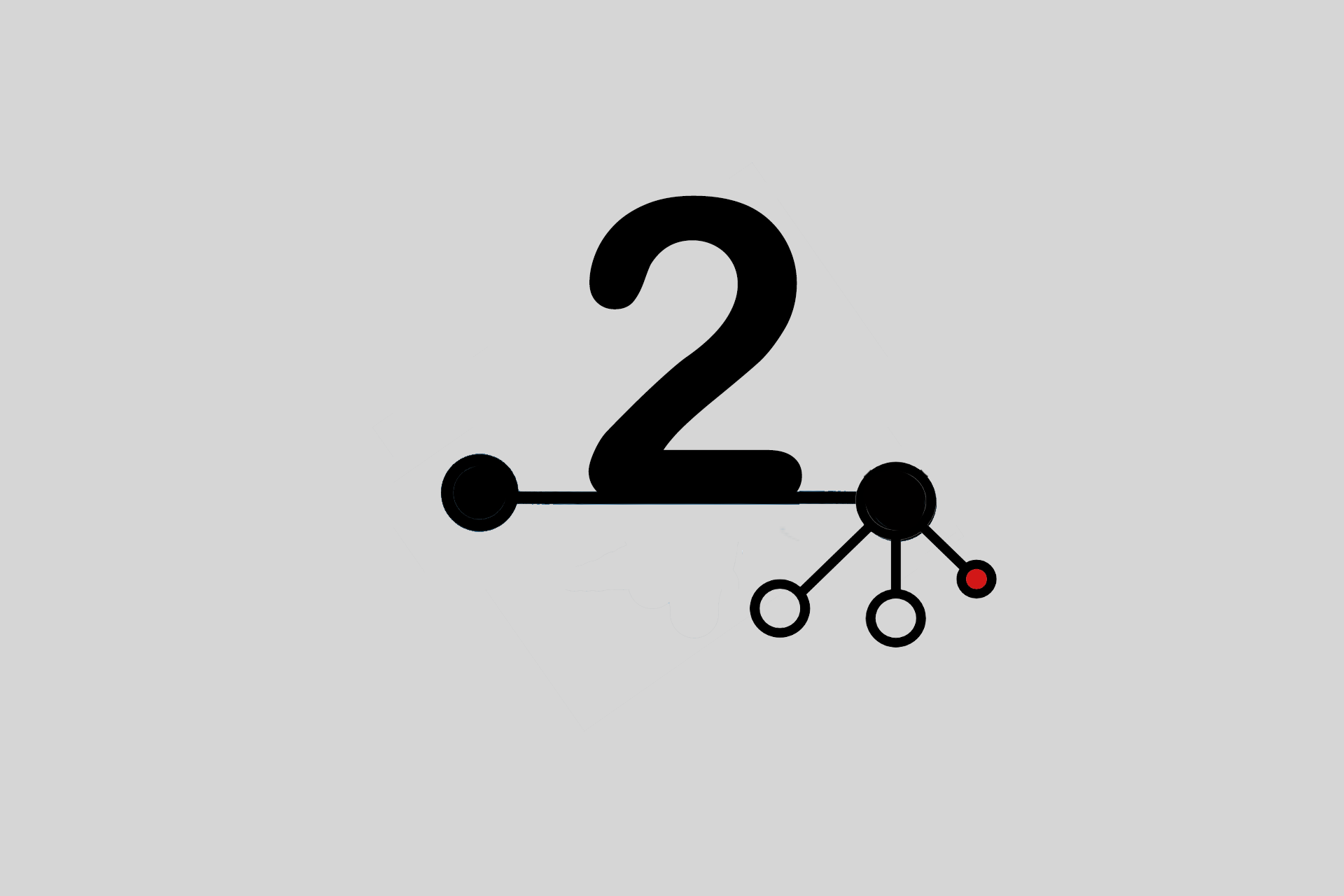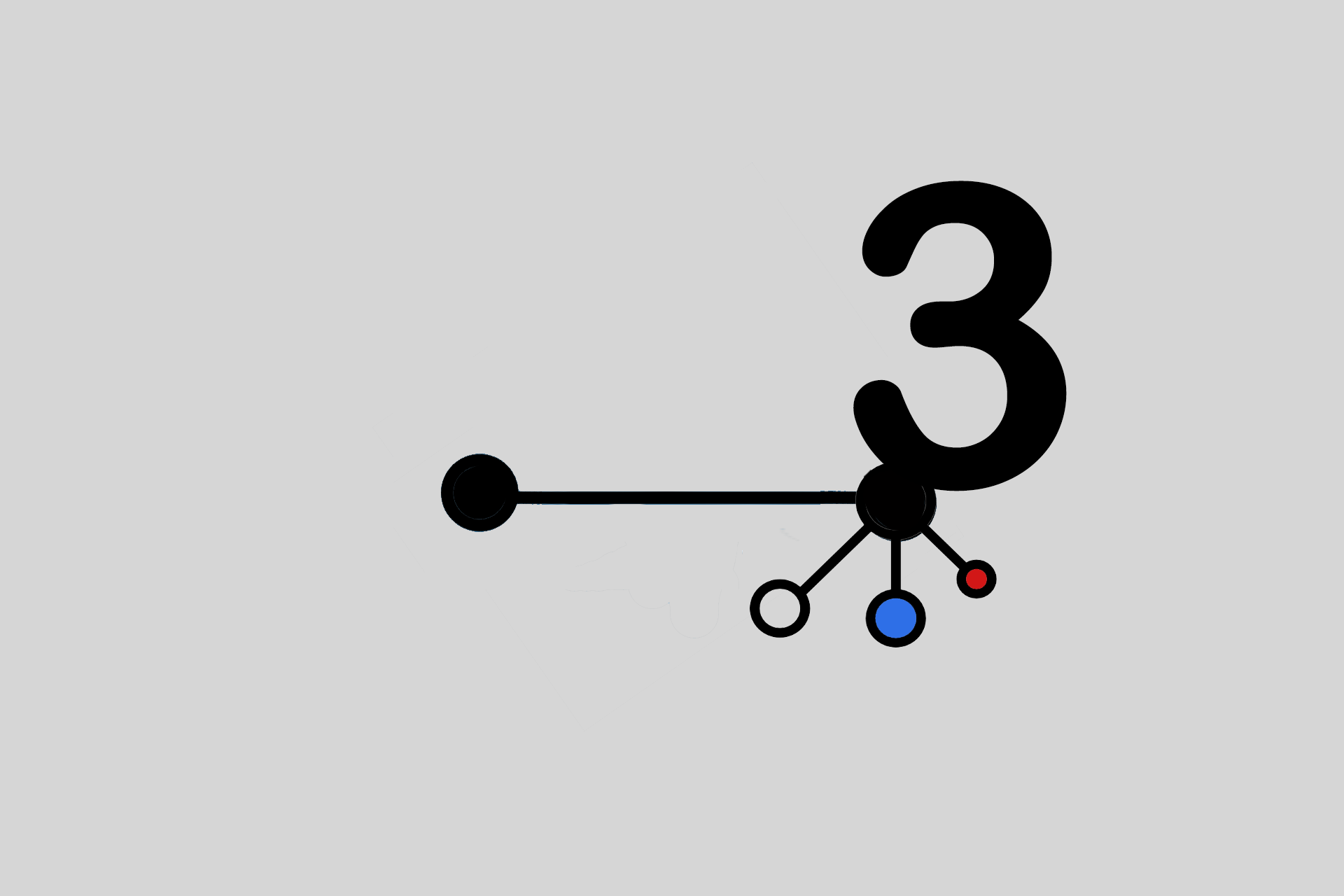Decision-making techniques for self-organised project teams – Part 4
FOR-DEC – A method for structured decision-making in project teams
In complex day-to-day project work, it is becoming increasingly difficult to keep an eye on the essentials and make decisions based on them. Psychological decision research shows that people tend to make ad hoc decisions, to be guided by pre-assumptions, to hold on to wrong goals for too long and to follow rules of thumb rather than analyse options adequately. A proven decision-making technique from aviation serves as a navigation aid in such situations: FOR-DEC.
FOR-DEC – Strategy for structured team decision-making
In civil aviation, “good decision-making” has been developed for years and a lot has been invested in it, because pilots have to decide situations under high time pressure again and again.
FOR-DEC is a method for structured decision-making developed by NASA.¹ Its purpose: to guide pilots and other aerospace managers to a good decision in difficult situations where it is sometimes literally a matter of life and death. The method is kept as simple as possible as a checklist so that it can be used safely even under stress, which is known to make thinking harder.
The word FOR-DEC or FORDEC is an acronym. It is formed from the first letters of the following terms:
- F – Facts
- O – Options
- R – Risks & Benefits
- D – Decision
- E – Execution
- C – Check
The first three letters stand for the discipline “Analysis”, the last three letters for the discipline “Implementation”. (I prefer the notation FOR-DEC, as this also shows the separation in the acronym).
Each letter or term stands for a single step. These are worked through sequentially in the appropriate order as a checklist. Guiding questions play an important role in this process:
- Facts: What is the problem? What is the situation?
- Options: What options for action arise from the facts?
- Risks and benefits: What are the arguments against the option (risk)? What speaks in favour of the option (opportunity)?
- Decision: What is the decision? What do we do?
- Execution: What are the individual steps? Who does what, when, how and where?
- Check: Is everything right? Have we improved? Do we have new facts? FOR-DEC start again?
The following model shows the operational use of the method:
Implementation of the FOR-DEC method
Facts – What is the situation?
What are the facts? A project team should not pass over this supposedly trivial point too quickly. It should be noted that no interpretations or assessments are made. The only thing that matters are the pure facts and a comprehensive picture of the initial situation.
When making decisions in the project team, everyone first answers this question on their own and then presents their view of things. It is important to gather the assessment of the facts from all participants in order to detect one-sided distortions or hierarchical influences at an early stage if possible. In addition, the goal to be achieved by the decision is defined, but options for solutions are not yet discussed.
Options – What are the possible courses of action?
After all the facts have been noted down, the question arises: “Which options for action result from the facts? It is important not to limit oneself to the obvious options.
The project team begins to list possible solutions without evaluating them. Discussions about evaluation should be stopped at all costs. How much time is put into collecting the options depends on the time criticality.
- In time-critical environments, it is better to make a decision quickly, observe its effects and correct the decision if necessary, than to put oneself in an awkward position by searching for options for too long.
- If the decision is not time-critical, it makes sense to take appropriate time and also note down unconventional ideas. These can always be deleted later. There are no prohibitions on thinking.
Risk & Benefits – What risks and benefits are associated with the respective courses of action?
This step describes the likelihood that the options can be implemented. The expected consequences of an expressed option for action / solution lead to the direct assessment of risks and opportunities.
The use of a simple representation with the naming of the option and one column each for “risks and disadvantages” or “benefits and advantages” has proven itself in practice. This gives project teams an overview and makes it more difficult to overestimate risks and overlook benefits. This is followed by a discussion for each option, which, if possible, takes into account the differentiation between the respective probability and impact.
In a non-time-critical set-up, a classic risk analysis can be carried out if necessary. This can have an influence on the decision, depending on the goal set.
Note: In the assessment, group dynamic effects such as the risky shift phenomenon should be taken into account. The risky shift phenomenon describes the effect that a group tends to make riskier decisions than the individual group members would.
This concludes the analysis part and moves on to implementation.
Decision – Which course of action is chosen?
All the information is now on the table. Now it is time to be consistent and make a decision. Brooding is like a “mental holding pattern”, valuable time passes. If the project team still finds it difficult to make a decision, it is possible to ask a third party for advice. As in aviation, a “co-pilot” can provide support. Outsiders often see things more clearly.
The final decision should be justified and receive commitment from the whole project team.
Execution – How will the option be carried out?
Now it is time to move quickly into action. Once it is clear what needs to be done, it is a question of who, when, how and where. Drawing up a catalogue of measures, including responsibilities, helps the project team to keep an overview.
The decision taken is communicated so that the necessary measures can be taken. These may include communicating the decision and intentions outside the FORDEC context.
Check – Does the chosen path lead to the goal?
FOR-DEC is not an “eyes closed and through” model. Especially in longer-term projects, it is necessary to regularly check whether the options for action are still on track and whether the measures decided upon are taking effect. This requires conscious monitoring of the situation and continuous checking of the benefits of the decision taken.
The check is essential, but is often neglected in ad hoc decision-making. It closes the loop for everything that has been done so far. If the check reveals that the previous procedure is not expedient, FOR-DEC has to be run through again. New facts, new findings from the project team, as well as external influences or the like lead to a new run, starting with the facts.
Tips for using the FOR-DEC method
It is important to use FOR-DEC correctly in practice: Often the method is used, but unfortunately in the wrong situations:
- Pay attention to whether a decision has actually already been made: Because then you don’t need an additional, structured procedure.
- Use this method when a decision has to be made quickly and there are no additional guidelines or checklists.
- Clarify where the priorities lie in the decision and only then begin with the implementation.
Pay attention to time!
In project teams, the use of FOR-DEC can sometimes lead to long discussions. Even if there is no direct time pressure, the team should set a time horizon (timebox) for the implementation of FOR-DEC.
Pay attention to authority gradients!
FOR-DEC thrives on the input of all project participants. In hierarchical set-ups or with strong, opinion-forming personalities in the project team, the facilitator should make sure that the quieter project team members or those lower in the hierarchy provide their input first during the individual steps. This avoids team members unconsciously joining the opinion leaders or superiors.
FOR-DEC cannot be delegated!
FOR-DEC is a decision-making process. In principle, only those can decide who are/were also involved in such a process. All steps are carried out by – always the same – project participants. A handover between the steps to other participants is not provided for and is in principle not conducive to the quality of decision-making.
In hierarchical set-ups, the method should not be used to prepare decisions for superiors.
Materials that support the use of FOR-DEC
FOR-DEC is a purely mental process and therefore does not require any materials.
For moderated decision-making processes in the team (brainstorming, etc.), suitable moderation materials (e.g. pin board, cards, whiteboard) can be helpful.
For the documentation of decision-making processes, a checklist (catalogue of measures) or a form (justification for the decision) can be useful.
Advantages of using FOR-DEC as a decision-making technique
In my view, FOR-DEC offers three key advantages:
- Generating and comparing several options compared to intuitive decisions is done in a structured way and with the involvement of all participants.
- The influence of mental error mechanisms (heuristics, cognitive biases) is minimised.
- The transparency of the decision-making process in team decisions is increased.
All three points are very important in practice, because the involvement of the participants, the joint search for the best solution for the situation, the transparency in the decision-making process (also in combination with the subsequent communication) increase the commitment of the participants to the decision taken.
Conclusion
FOR-DEC can be used very well for decision-making. It is a tool to look at a situation from different perspectives based on facts, and to identify options based on knowledge and experience. In my opinion, the structured approach with its 6 steps ensures an optimal response to crises.
Finally, the most important thing: a situation does not end with the decision taken. In aviation, as in business, it is not the decisions we make that count, but the results. If these do not turn out as desired, then there is only one suitable option: start again with FOR-DEC!
Notes:
In the next part of the series of articles, Cornelia Kiel will explain further decision-making techniques.
[1] In autumn 1992, Lufthansa and the Department of Aviation and Space Psychology (DLR) founded a working group for Crew Resource Management (Soll, H et al.: Decision-Making Tools for Aeronautical Teams: FOR-DEC and Beyond, Aviation Psychology and Applied Human Factors, 2016, 6 (2), 101-112). As part of this working group, Hans-Jürgen Hörmann developed FORDEC as a decision-making model (Hörmann, H. J.: FOR-DEC – A Prescriptive Model for Aeronautical Decision Making, 21st WEAAP Conference, Dublin, 1994).
Literature to read (in German):
Article FORDEC from projektmagazin, 2018
Die FORDEC Methode – Checkliste für gute Entscheidungen, Philipp Keil
Cornelia Kiel has published other articles on the t2informatik Blog:

Cornelia Kiel
Cornelia Kiel has been managing projects intelligently and sustainably for over 20 years. She uses a wide range of methods: from the waterfall to the V-model and the various agile frameworks such as Scrum, Kanban or SAFe – always in the interests of an efficient project.
Her clients benefit from her extraordinary wealth of experience as a project manager, ScrumMaster, AgileCoach, moderator and BVMW-certified consultant for medium-sized companies.
In the beginning there is always the question of why. – Even as a child she drove her father to despair with this. – With this curiosity, Cornelia Kiel will work with you to find out the meaning and purpose of your project. The question of the benefit for your customer is also answered. From this starting point, you will reach the goal of your project in a focused manner.



